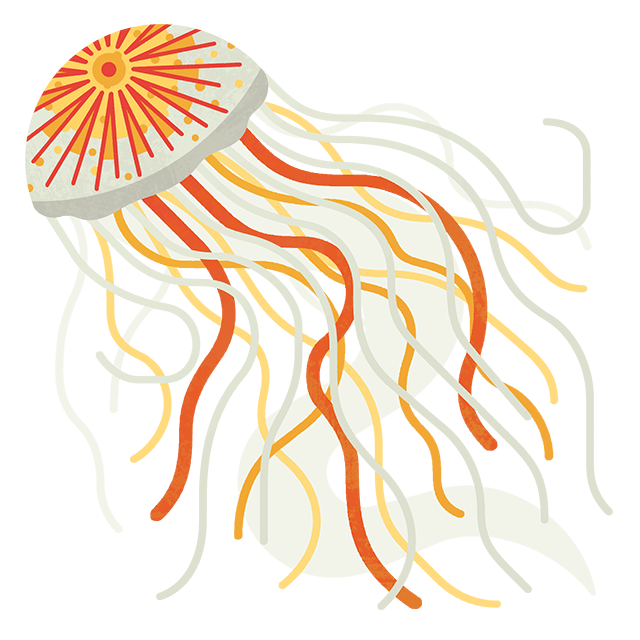
Rare but beautiful: Less common jellyfish you can find in UK waters
Our seas are full of jellyfish. You might be aware of - or seen - some of the more common species, like lion's mane or moon jellies. But there are some species which are less often seen, but just as fascinating.
Comb
Despite their name, comb jellies aren’t actually jellyfish – and they don’t sting!
Jellyfish are cnidarians, whereas comb jellies are Phylum ctenophora, which comes from the Greek meaning “comb carrying”.
There are 150 identified species of comb jellies to date, which range in size from a tiny 0.1 millimetres to almost 1.5 metres!
They can be found all over the world, from warm tropical waters to the more icy ones of the poles - and the UK.
This is because they have rows of ‘cilia’, resembling combs, which they use to move. The rows of cilia run the length of their bodies and are bioluminescent, meaning they can scatter light, causing a rainbow effect.
Comb jellies are believed to be the first animal species to split off from the common ancestor, of which all animals descended, and begin evolving separately.
Although all animals are related, comb jellies have been found to possess a distinctive pattern of genes which aren’t shared in other species, suggesting they were the first animals to diverge and evolve into what they are today.
Crystal
This is another bioluminescent species of jellyfish, meaning that they can emit light.
The Aequorea victoria, which gets the name ‘crystal jellyfish’ from its clear translucent colour, can glow green or blue due to proteins which give out light.

Credit: Kondratuk Aleksei
Crystal jellyfish have delicate tentacles (up to 150!) and their bells grow up to 25cm in diameter, with fine white lines coming out from the centre.
They feed on other jellyfish, including comb jellies, and have been known to eat jellyfish bigger than themselves!
Crystal jellyfish are commonly seen our shores, but not often noticed as they are relatively small, fragile and break up easily in the surf.
The number reported to us are gradually rising each year: they made up 1% of total sightings three years ago, but this has since increased to 4%. So, it’s definitely worth keeping an eye out!
Stalked
Stalked jellyfish, or Stauromedusae, are a distinctive trumpet-shape, made up of a thick stalk and eight protruding arms. On the ends of these arms are tentacles with suckers which they use to case prey.
Their stalks also have a sucker on the end – this is used for attaching the jellyfish to things like rocks, the seabed, or marine plants such as eelgrass.
Stalked jellyfish are small, growing up to 4.5cm, and can either be red, green, or brown.
Unlike typical jellyfish, stalked jellyfish live in rockpools and shallow waters along our shores, and are often seen attached to seaweed or eelgrass, which they feed from.
Although found in UK and Irish seas, stalked jellyfish can be hard to spot due to their small size and are often well camouflaged against the plants they’re on.
White cross
The Mitrocoma cellularia, also known as the ‘white cross’ or ‘cross’ jellyfish, gets its name from the distinctive cross on its transparent bell, formed by four white canals.

Credit: Annie Leblanc
Growing up to 10cm in diameter, white cross jellyfish have a thin bioluminescent band around their bells, which glows when disturbed, giving off a blue-green colour.
They have hundreds of delicate tentacles and a thin membrane inside their bells which enables them to swim pretty quickly.
White cross jellyfish tend to eat zooplankton and studies have suggested that this species of jellyfish may be able to smell and sense its prey.
These jellyfish are found in our coastal waters but are not often reported. However, sightings of cross jellyfish more than doubled last year, with 13 recorded.
Sea gooseberry
Sea gooseberries, or Pleurobrachia pileus are a species of comb jellies.
Growing up to 2.5cm, they have a translucent, oval-shaped bell with eight rows of ‘combs’ running down it, giving them the appearance – and name – of a gooseberry.
These combs of cilia beat in waves, propelling the sea gooseberry along and giving it a shimmering effect. They’re also phosphorescent, meaning that they glow in the dark!
Sea gooseberries only have two tentacles, and these can grow up to 50cm long – that’s 20x the length of their bodies!
These creatures are commonly found in UK and Irish waters, particularly in Summer. They can be very hard to spot, though, due to their small size and see-through appearance.







